Abstract
Lymph-borne dendritic cells (L-DC) collected from the thoracic duct of rats following mesenteric lymphadenectomy are derived from the small intestine. We have cultured these cells in vitro and examined their survival and phenotypic and functional changes. L-DC survive poorly in culture in normal media (less than 50% overnight) but survival can be markedly increased by supplementation with Con A-stimulated spleen cell supernatant or recombinant granulocyte-macrophage colony-stimulating factor (GM-CSF) but not by recombinant IL-1, IL-2, IFN-gamma or by an IL-3-rich supernatant. The effects of GM-CSF are blocked by a specific antiserum. L-DC display heterogeneity for some surface markers, cytoplasmic inclusions and enzyme reactivity. After 16-48 hr culture the pattern of expression is markedly different. The numbers of Thy-1-positive L-DC and the amount of Thy-1 expressed increases, as do the numbers of L-DC expressing OX48 antigen. All L-DC remain Ia positive, but the proportion expressing the iC'3b receptor, non-specific esterase or cytoplasmic DNA inclusions decreases to almost zero. In contrast to Langerhans' cells, fresh L-DC are potent stimulators of an allogeneic mixed leucocyte reaction (MLR) but their potency is considerably increased after 16 hr culture. Also in contrast to Langerhans' cells, the increase in potency is not affected by culture with CAS and is thus unlikely to be dependent on GM-CSF. The changes described in L-DC properties could be related to their role as antigen-presenting cells.
Full text
PDF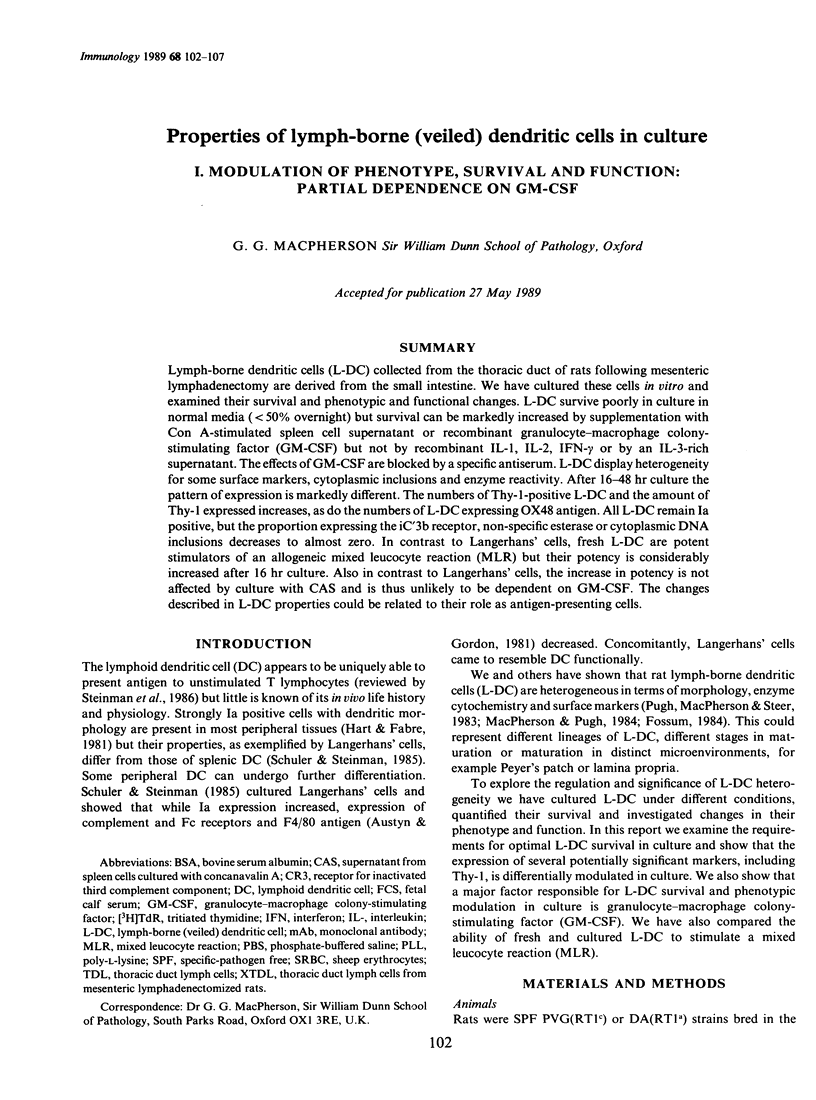
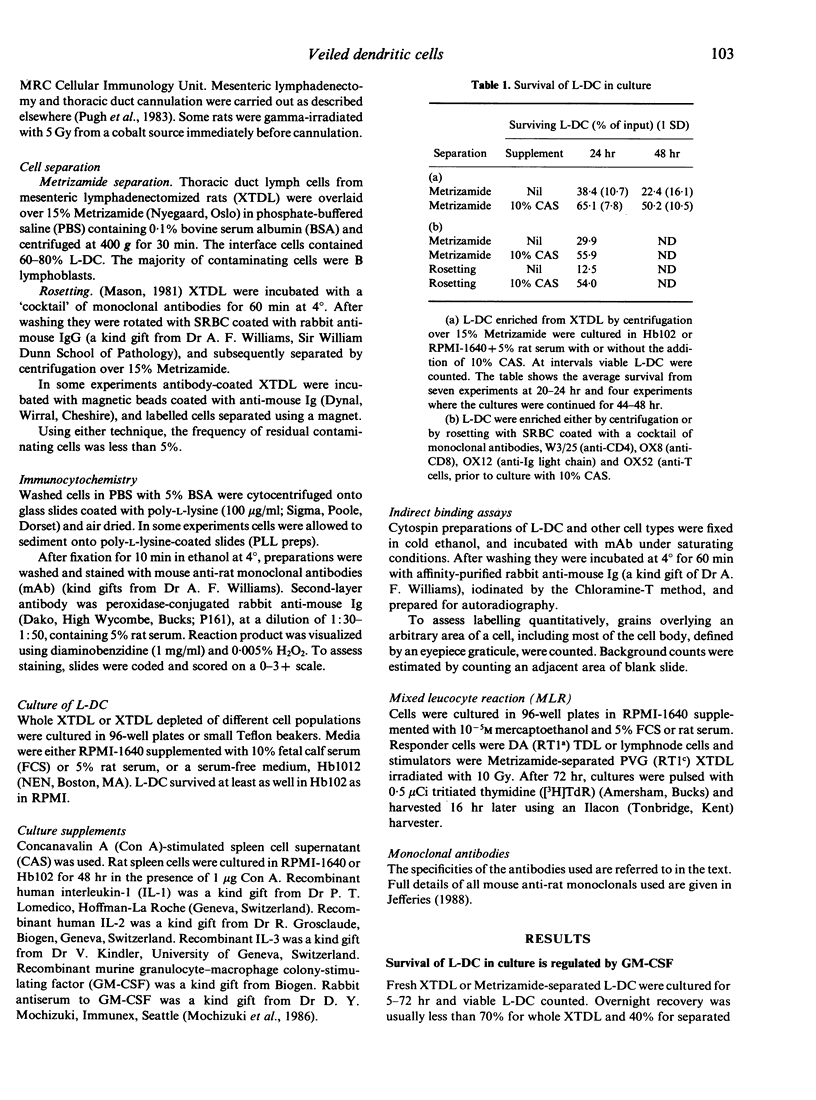
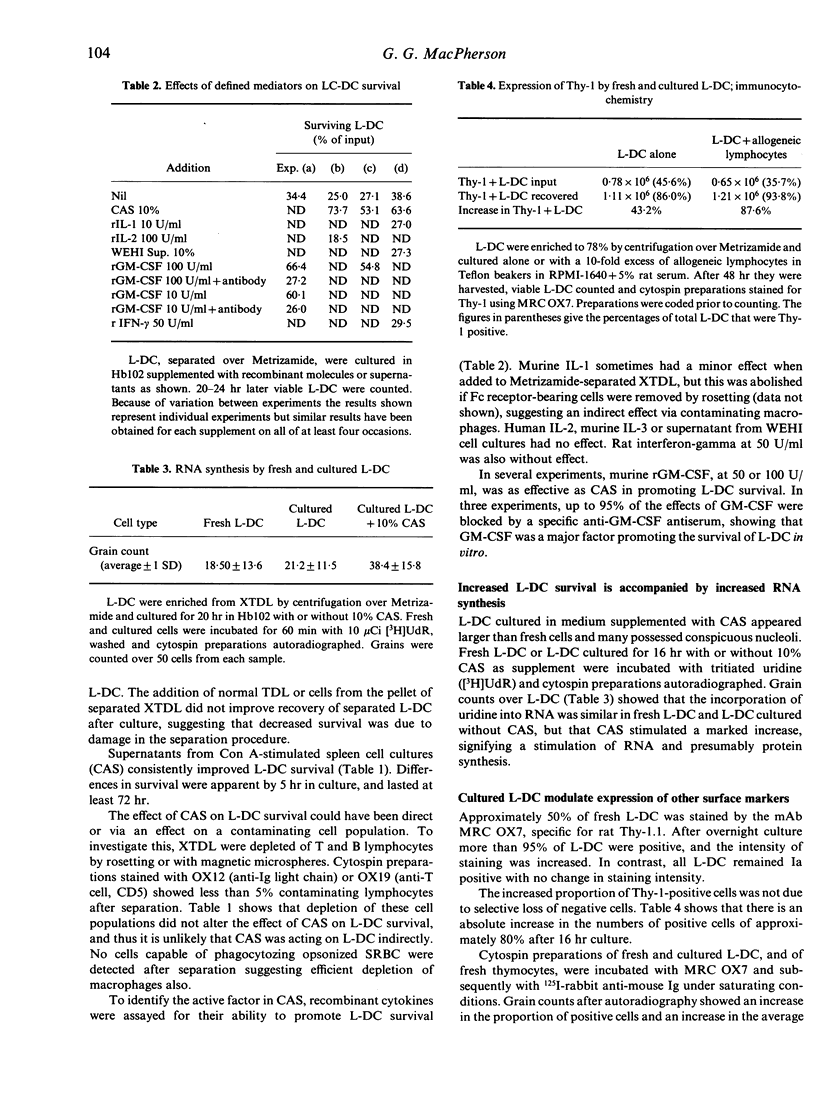
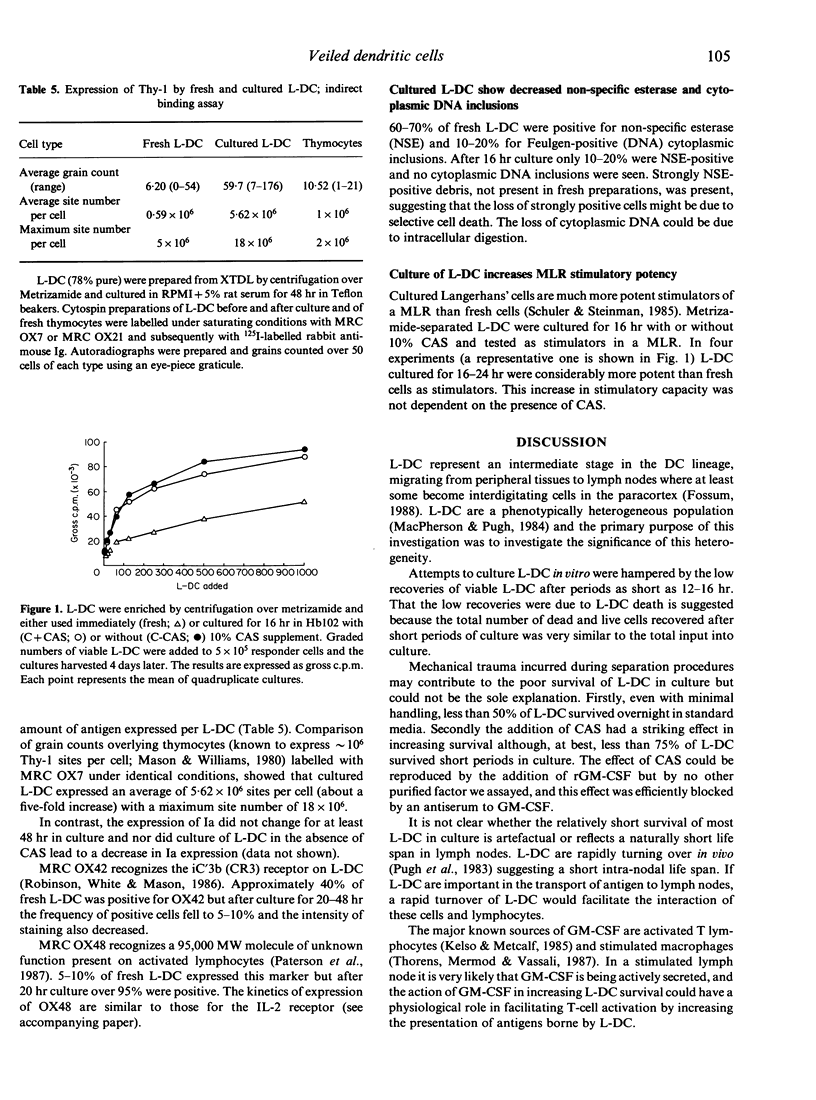
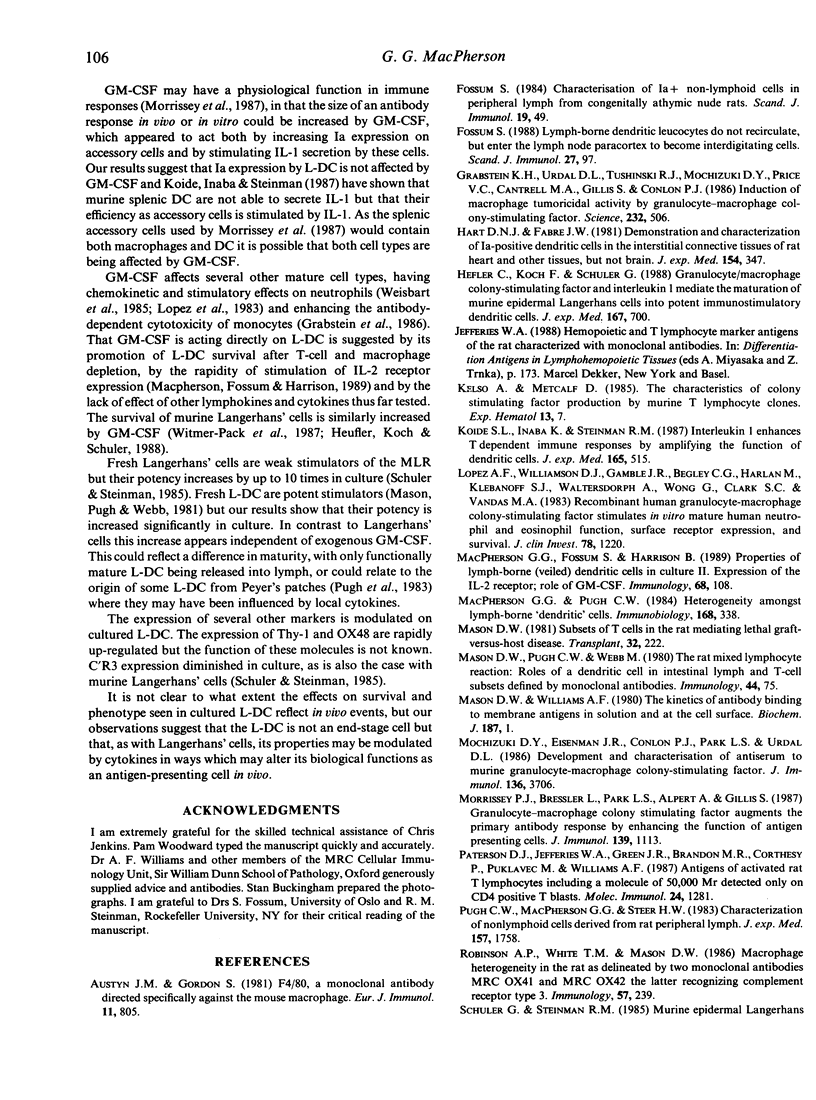
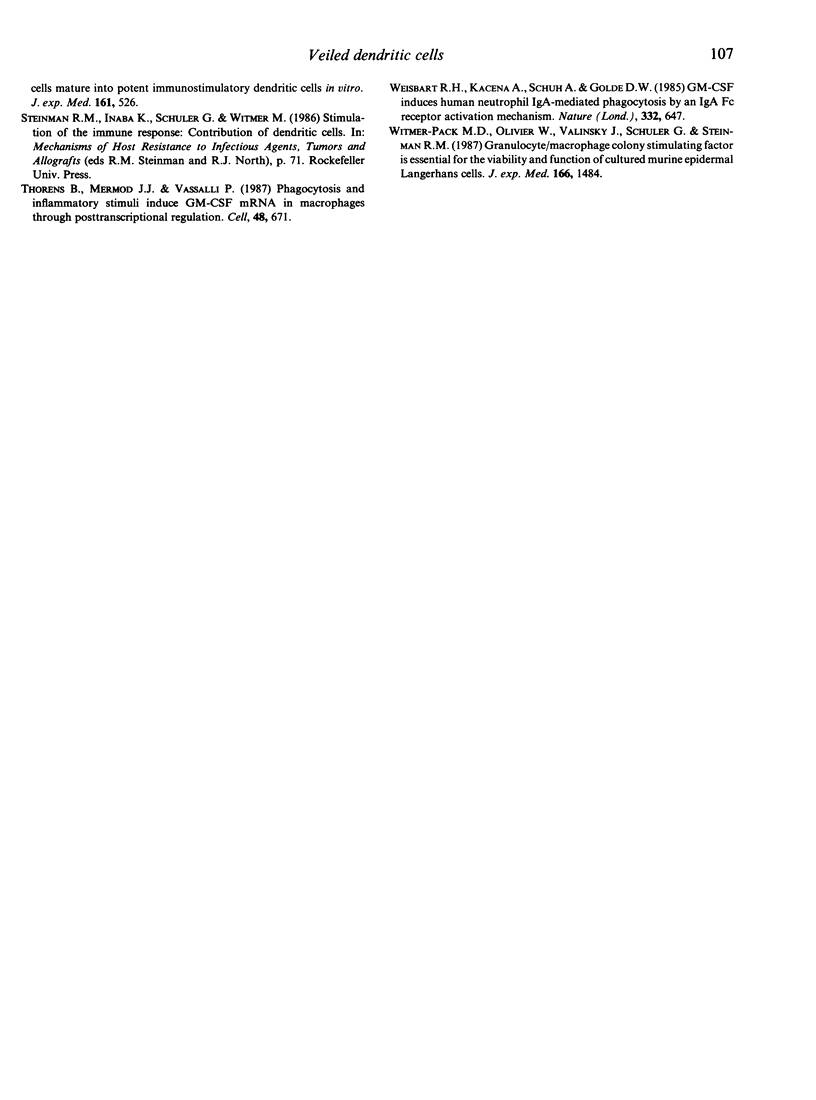
Selected References
These references are in PubMed. This may not be the complete list of references from this article.
- Austyn J. M., Gordon S. F4/80, a monoclonal antibody directed specifically against the mouse macrophage. Eur J Immunol. 1981 Oct;11(10):805–815. doi: 10.1002/eji.1830111013. [DOI] [PubMed] [Google Scholar]
- Fossum S. Characterization of Ia+ non-lymphoid cells in peripheral lymph from congenitally athymic nude rats. Scand J Immunol. 1984 Jan;19(1):49–61. doi: 10.1111/j.1365-3083.1984.tb00899.x. [DOI] [PubMed] [Google Scholar]
- Fossum S. Lymph-borne dendritic leucocytes do not recirculate, but enter the lymph node paracortex to become interdigitating cells. Scand J Immunol. 1988 Jan;27(1):97–105. doi: 10.1111/j.1365-3083.1988.tb02326.x. [DOI] [PubMed] [Google Scholar]
- Grabstein K. H., Urdal D. L., Tushinski R. J., Mochizuki D. Y., Price V. L., Cantrell M. A., Gillis S., Conlon P. J. Induction of macrophage tumoricidal activity by granulocyte-macrophage colony-stimulating factor. Science. 1986 Apr 25;232(4749):506–508. doi: 10.1126/science.3083507. [DOI] [PubMed] [Google Scholar]
- Hart D. N., Fabre J. W. Demonstration and characterization of Ia-positive dendritic cells in the interstitial connective tissues of rat heart and other tissues, but not brain. J Exp Med. 1981 Aug 1;154(2):347–361. doi: 10.1084/jem.154.2.347. [DOI] [PMC free article] [PubMed] [Google Scholar]
- Heufler C., Koch F., Schuler G. Granulocyte/macrophage colony-stimulating factor and interleukin 1 mediate the maturation of murine epidermal Langerhans cells into potent immunostimulatory dendritic cells. J Exp Med. 1988 Feb 1;167(2):700–705. doi: 10.1084/jem.167.2.700. [DOI] [PMC free article] [PubMed] [Google Scholar]
- Koide S. L., Inaba K., Steinman R. M. Interleukin 1 enhances T-dependent immune responses by amplifying the function of dendritic cells. J Exp Med. 1987 Feb 1;165(2):515–530. doi: 10.1084/jem.165.2.515. [DOI] [PMC free article] [PubMed] [Google Scholar]
- Lopez A. F., Williamson D. J., Gamble J. R., Begley C. G., Harlan J. M., Klebanoff S. J., Waltersdorph A., Wong G., Clark S. C., Vadas M. A. Recombinant human granulocyte-macrophage colony-stimulating factor stimulates in vitro mature human neutrophil and eosinophil function, surface receptor expression, and survival. J Clin Invest. 1986 Nov;78(5):1220–1228. doi: 10.1172/JCI112705. [DOI] [PMC free article] [PubMed] [Google Scholar]
- MacPherson G. G., Fossum S., Harrison B. Properties of lymph-borne (veiled) dendritic cells in culture. II. Expression of the IL-2 receptor: role of GM-CSF. Immunology. 1989 Sep;68(1):108–113. [PMC free article] [PubMed] [Google Scholar]
- MacPherson G. G., Pugh C. W. Heterogeneity amongst lymph-borne "dendritic" cells. Immunobiology. 1984 Dec;168(3-5):338–348. doi: 10.1016/S0171-2985(84)80121-7. [DOI] [PubMed] [Google Scholar]
- Mason D. W. Subsets of T cells in the rat mediating lethal graft versus-host disease. Transplantation. 1981 Sep;32(3):222–226. doi: 10.1097/00007890-198109000-00008. [DOI] [PubMed] [Google Scholar]
- Mason D. W., Williams A. F. The kinetics of antibody binding to membrane antigens in solution and at the cell surface. Biochem J. 1980 Apr 1;187(1):1–20. doi: 10.1042/bj1870001. [DOI] [PMC free article] [PubMed] [Google Scholar]
- Mochizuki D. Y., Eisenman J. R., Conlon P. J., Park L. S., Urdal D. L. Development and characterization of antiserum to murine granulocyte-macrophage colony-stimulating factor. J Immunol. 1986 May 15;136(10):3706–3709. [PubMed] [Google Scholar]
- Morrissey P. J., Bressler L., Park L. S., Alpert A., Gillis S. Granulocyte-macrophage colony-stimulating factor augments the primary antibody response by enhancing the function of antigen-presenting cells. J Immunol. 1987 Aug 15;139(4):1113–1119. [PubMed] [Google Scholar]
- Paterson D. J., Jefferies W. A., Green J. R., Brandon M. R., Corthesy P., Puklavec M., Williams A. F. Antigens of activated rat T lymphocytes including a molecule of 50,000 Mr detected only on CD4 positive T blasts. Mol Immunol. 1987 Dec;24(12):1281–1290. doi: 10.1016/0161-5890(87)90122-2. [DOI] [PubMed] [Google Scholar]
- Pugh C. W., MacPherson G. G., Steer H. W. Characterization of nonlymphoid cells derived from rat peripheral lymph. J Exp Med. 1983 Jun 1;157(6):1758–1779. doi: 10.1084/jem.157.6.1758. [DOI] [PMC free article] [PubMed] [Google Scholar]
- Robinson A. P., White T. M., Mason D. W. Macrophage heterogeneity in the rat as delineated by two monoclonal antibodies MRC OX-41 and MRC OX-42, the latter recognizing complement receptor type 3. Immunology. 1986 Feb;57(2):239–247. [PMC free article] [PubMed] [Google Scholar]
- Schuler G., Steinman R. M. Murine epidermal Langerhans cells mature into potent immunostimulatory dendritic cells in vitro. J Exp Med. 1985 Mar 1;161(3):526–546. doi: 10.1084/jem.161.3.526. [DOI] [PMC free article] [PubMed] [Google Scholar]
- Thorens B., Mermod J. J., Vassalli P. Phagocytosis and inflammatory stimuli induce GM-CSF mRNA in macrophages through posttranscriptional regulation. Cell. 1987 Feb 27;48(4):671–679. doi: 10.1016/0092-8674(87)90245-5. [DOI] [PubMed] [Google Scholar]
- Weisbart R. H., Kacena A., Schuh A., Golde D. W. GM-CSF induces human neutrophil IgA-mediated phagocytosis by an IgA Fc receptor activation mechanism. Nature. 1988 Apr 14;332(6165):647–648. doi: 10.1038/332647a0. [DOI] [PubMed] [Google Scholar]
- Witmer-Pack M. D., Olivier W., Valinsky J., Schuler G., Steinman R. M. Granulocyte/macrophage colony-stimulating factor is essential for the viability and function of cultured murine epidermal Langerhans cells. J Exp Med. 1987 Nov 1;166(5):1484–1498. doi: 10.1084/jem.166.5.1484. [DOI] [PMC free article] [PubMed] [Google Scholar]


